‘Make It Your Own’: Meyndert and Emmy on 30 Years of Binnenpret
In 1984 when a large squat in the centre of Amsterdam was going to be evicted, the squatting movement decided to devote a day to ‘squatting back’ as many buildings as possible. One group squatted 14-16 Schinkelstraat, now known as the Binnenpret
: a space with, among other things, restaurant MKZ, practice rooms for musicians, a library and the venue OCCII with its entrance on Amstelveenseweg. Next weekend Binnenpret celebrates its thirtieth birthday. Meyndert and Emmy who were there from day one, tell about the thrills of squatting, endless rebuilds, and the secret of a squatted space.
“It was squatted at 7 at night, I believe,” Meyndert says, “ and on February 10th, it was dark already at this time. I lived in the neighbourhood in a squat at the Postjeskade and I met someone on the street who said ‘That was a great squat!’, so I asked ‘Which squat?’ I went there right away!”
Meyndert and Emmy drink cherry juice and smoke tobacco in the Bollox, a coffee bar and library in the garden of the Binnenpret. Thirty years after the squat they’re still active at the Binnenpret. Meyndert has lived here for almost thirty years, and Emmy works at the Bollox and takes care of “the surroundings” as she calls it: “Taking empty bottles and paper to the recycling, and making sure that there are candles, the kind of things that you easily forget.” Even though Emmy first has to clean and finish some things, they feel like doing an interview – “with grandpa and grandma of the Binnenpret,” Meyndert chuckles.
 The Binnenpret was squatted on February 10th, 1984, on the “Day of Unrest,” as the squatting movement calls it. On this Friday a large number of new places were squatted in the Netherlands. This wave of squats was a reaction to the planned eviction of the extensive Wijers squat on the Nieuwezijds Voorburgwal.
The Binnenpret was squatted on February 10th, 1984, on the “Day of Unrest,” as the squatting movement calls it. On this Friday a large number of new places were squatted in the Netherlands. This wave of squats was a reaction to the planned eviction of the extensive Wijers squat on the Nieuwezijds Voorburgwal.
Emmy doesn’t remember how the squat went exactly, there were so many during that period and can’t tell them apart anymore. “You enter a squat and make a schedule with the people that are there, then you go home and get bedclothes. At night you get together again and then you drink and you chat.” “A lot,” Meyndert adds, “the Binnenpret was built on alcohol those first years!”Soon it became clear that Binnenpret squat was quite special, especially because of the possibility to go to many different directions in one place: a restaurant, a children’s theatre, practice spaces, and even a venue. “After you squat a place” says Meyndert, “you walk around a bit, you want to take a look everywhere. That’s the thrill of squatting: you enter a new space and your creativity rises. This way we discovered there was another building that went all the way to the Amstelveenseweg. We spontaneously squatted it too. It became the venue OCCII.” “Because Wijers was going to be evicted a few days later,” adds Emmy, “we at the Binnenpret said: ‘Move your sauna and your shop and whatever to the Binnenpret.’ It was fully booked soon.”
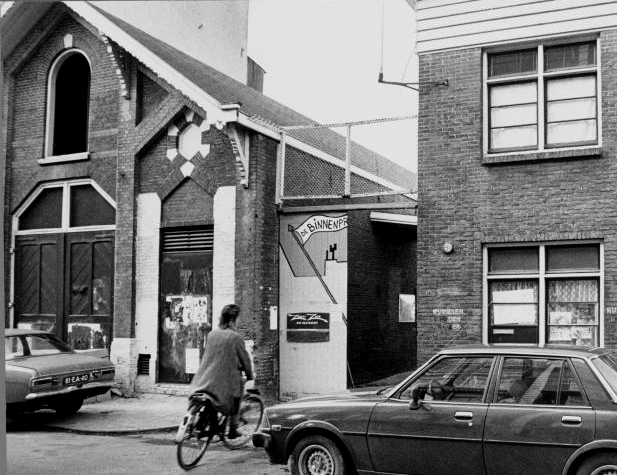


“That period was very different anyway,” Emmy says. “For such a small neighbourhood there were a lot of squats. In every street there was one. “The squatters’ consultation hour was even organised together with the community centre back then,” says Meyndert, “the community centre in turn made sure that the neighbourhood would profit from your squat. So we had a Moroccan youth centre in the Binnenpret, and the day care for toddlers was their initiative too.” But besides the social function squatting had back then, it was most of all fun, Emmy and Meyndert think. “There was a vacant cinema in the Schinkelbuurt area,” Meyndert says, “that was squatted, Victoria. It gave the neighbourhood a boost because that was where the parties were. It was an anarchist mess, but it was beautiful.”
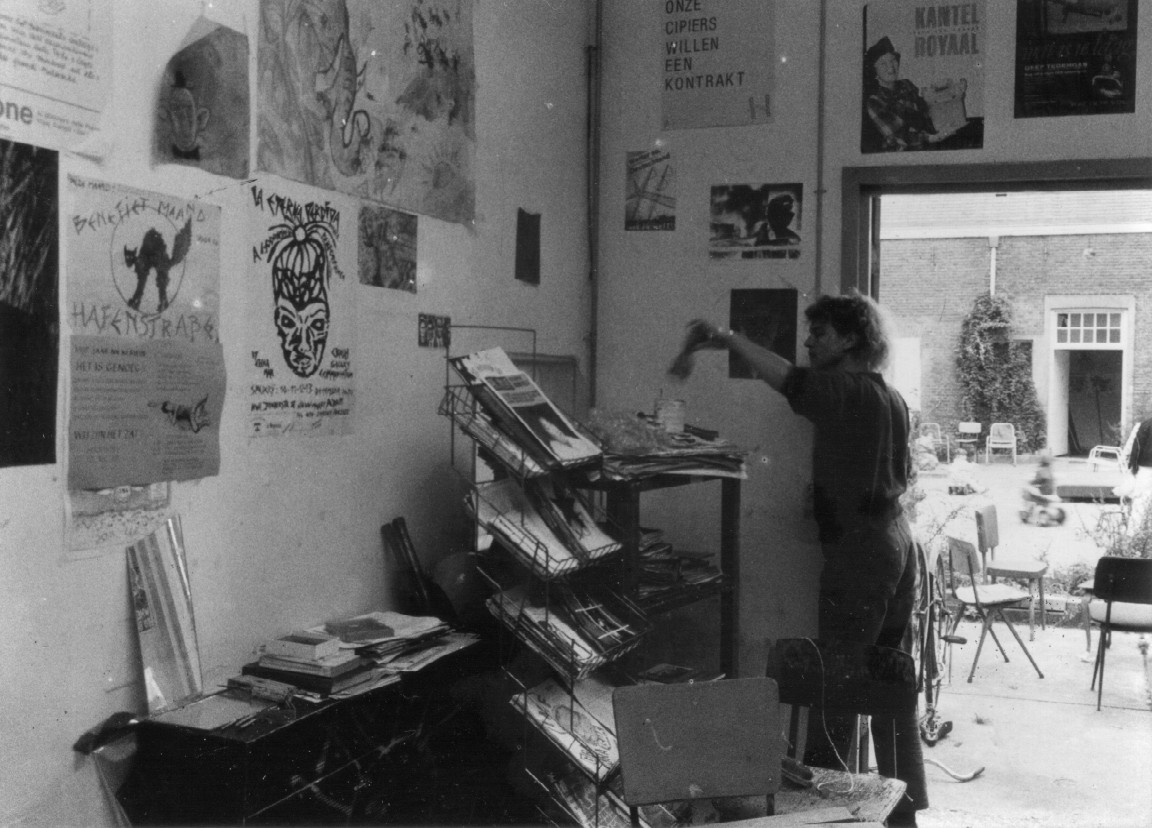

“I lived in Noordwijk and was part of the local squatting scene,” Emmy says. “Well, scene… it was probably six to ten people. In Amsterdam there were already thousands of squatters. One of my colleagues had a brother who was active in the Amsterdam scene. She often took me there. At one point I was more in Amsterdam than in Noordwijk, so I moved.”
“It was possible to be a fulltime activist back then,” Emmy continues. “Every day there was something to do. You either helped out in the neighbourhood, or helped with a squat or occupation to prevent eviction. You demonstrated, you cooked. And most of all, you were building.”
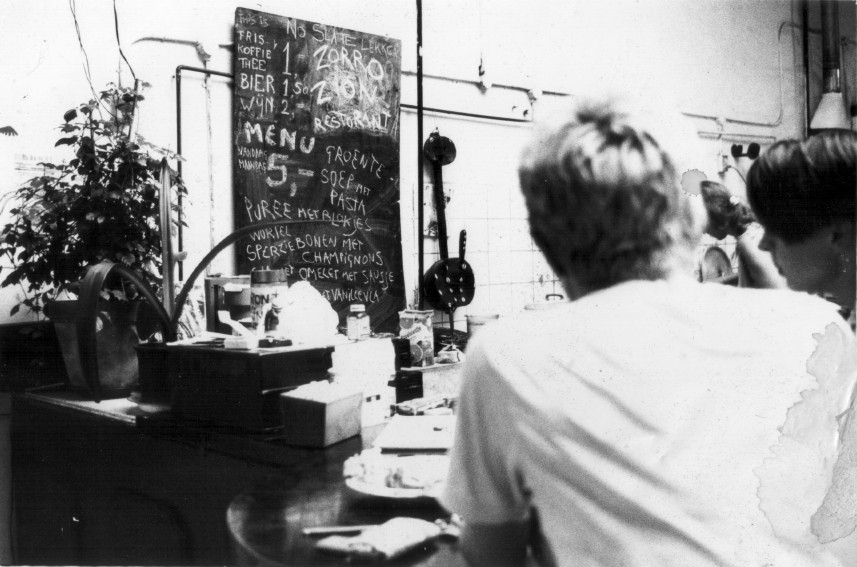

In the end, all of the rebuilding made it possible for artists and activists to meet in a squat that was flexible enough to host a wide variety of initiatives. Whether it was a political festival, children’s theatre, or a rehearsal with a new band, there was room for it, and it hardly cost any money. According to Meyndert the secret to a well functioning alternative space is still squatting: “If you obtain a building in a legal way, then you’ll need a business plan, which means you need money first. Then you’ll have to present floor plans, estimates of all sorts, those kinds of things. In the way we did it here, you worked with whatever you found, often with the help of neighbours. It regularly occurred that you’d wake up in the morning and there would be a whole pile of building plates stacked against the wall. People offered us all kinds of things.”


While there were still thousands of squatters in the eighties, in 2014 the amount is only a fraction of what it once was. The ban on squatting in 2011 led to a large number of evictions. So, are these veteran squatters concerned about the disappearance of many squats? “In Amsterdam’s race to lure tourists,” Emmy says, “the city is transforming into a safe and clean-looking place. If the Vrankrijk [a legalised squat in the centre of Amsterdam] could be evicted, the government would do so. But they can’t because the building was actually bought. Now, if you start a new squat, you can only stay for a few months max, until the next eviction round. But concerned… I’m concerned about something that is much more far-reaching than our own little scene: the crisis that was caused by large banks, and that everybody is now paying for. It takes away from social projects. The most scandalous thing is that those guys just got away with it. It’s super annoying.”
“Being concerned is not really my attitude.” Meyndert says, “I’m quite optimistic, like a hippie. I believe in communication. The way children communicate with their parents nowadays is so different from how we were expected to interact with ours. My parents’ generation, let’s say 80, 90 and deceased, they simply didn’t communicate. They spoke in slogans, from their political conviction, or their religion. Everything was laid out in advance, and that has changed now. In the end I think that the rise of communication that we started can help find solutions for the bigger problems. A lot has to be done still, but I often think: we live in the best time ever.”
The Binnenpret has a leasehold contract with the municipality until 2023. “We rent the land,” Meyndert explains, “and we own the building, which we also maintain. This means that we cannot sell the land, which is a good thing, because this way nobody can rebuild the place and then throw people out to sell it.”
Do they often think about how things will be after 2023? “Well,” says Meyndert, “we’re here, so we’re already something to be reckoned with. The Binnenpret is like an octopus, its tentacles go in many directions, with every initiative here having contacts with other groups outside of the Binnenpret. We have a function in society, and I’m pretty sure that will stay.”
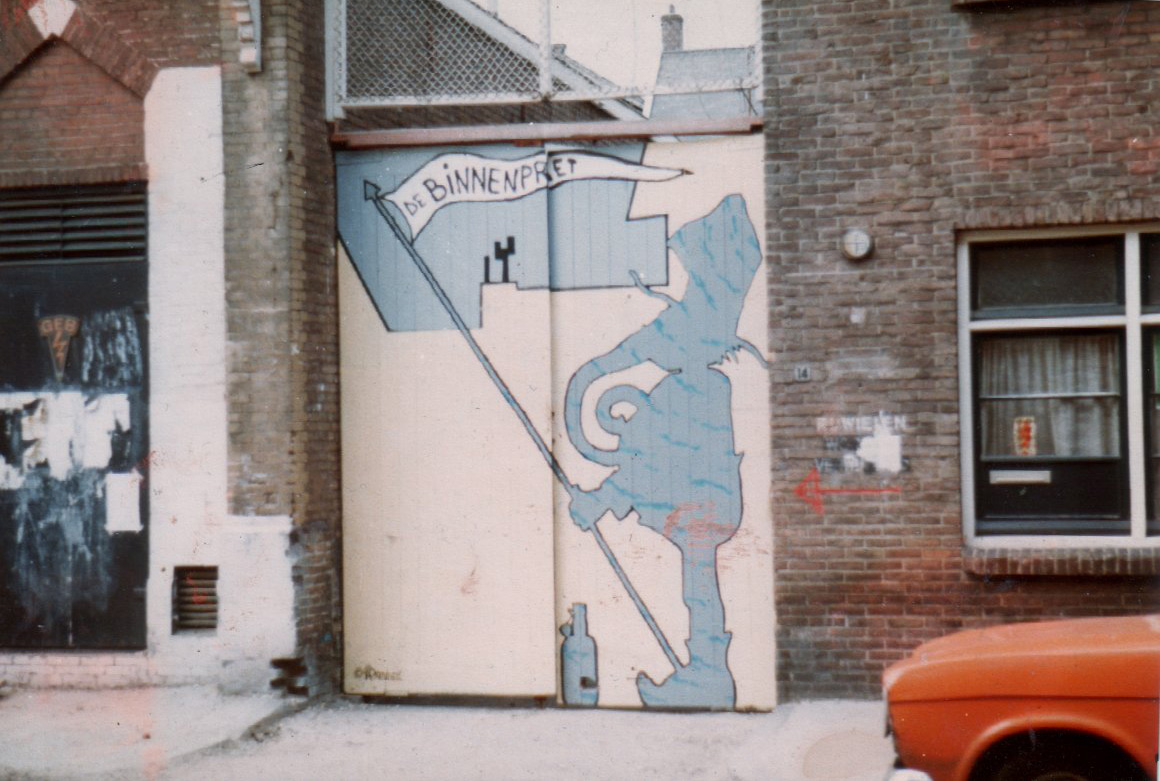

If indeed better times are ahead for small social initiatives, then the old squatter’s mentality, that never really went away in the Binnenpret never, might also not seem that outdated anymore. “If you squat something and you abide, and don’t do anything until you know how long you can stay, it leaves me flabbergasted,” Meyndert says, while he rolls a cigarette for later,“Then I think: ‘Great guys, just sit back and wait. No, you should make sure you make a place your own while you’re there.”
The Binnenpret celebrates its 30th birthday on February 15th at OCCII. There will be shows, DJs and it is also a benefit for Stichting Theaterstraat. See the full schedule here.
Images: Binnenpret archive.
View more old photos of Binnenpret.
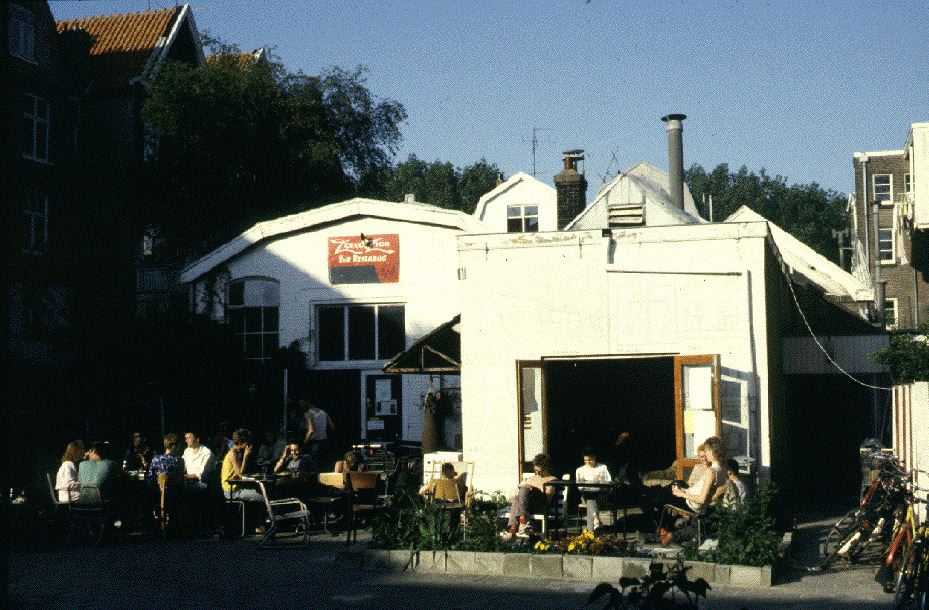

Zorg dat het van jou is: Meyndert en Emmy over 30 jaar Binnenpret
Toen in 1984 een groot kraakpand in het centrum van Amsterdam ontruimd zou worden, besloot de kraakbeweging een dag lang zo veel mogelijk ‘terug’ te kraken. Aan de Schinkelstraat 14-16 bezette een groepje een gebouwencomplex dat nu bekend is als de Binnenpret: een vrijplaats met o.a. restaurant MKZ, oefenruimtes, een infobibliotheek, en de concertzaal OCCII die haar ingang aan de Amstelveenseweg heeft. Volgend weekend viert de Binnenpret haar dertigste verjaardag. Meyndert en Emmy waren er vanaf die eerste dag bij. Ze vertellen over de kick van kraken, eindeloze verbouwingen en het geheim van de vrijplaats.
“Het is om 7 uur ’s avonds gekraakt geloof ik,” zegt Meyndert. “Op 10 februari, en het was al donker. Ik woonde in de buurt in een pand op de Postjeskade en kwam iemand tegen die zei ‘Leuke kraak was dat!’ Dus ik vroeg: ‘Welke kraak?’ Ik ben er gelijk naartoe gegaan!” Meyndert en Emmy zitten met kersensap en een sjekkie in de Bollox, het infocafé in de binnentuin van de Binnenpret. Dertig jaar na de kraak zijn ze nog steeds actief in de Binnenpret. Meyndert woont er ondertussen al bíjna dertig jaar en Emmy werkt om de week in de Bollox en zorgt voor ‘de entourage’ zoals ze het zelf zegt: “Lege flessen en papier wegbrengen en zorgen dat er kaarsen zijn, van die dingen die je makkelijk vergeet.” Hoewel er eerst van alles opgeruimd en afgemaakt moet worden, hebben ze wel zin in een interview – “Met opa en oma van de Binnenpret,” grinnikt Meyndert.



Hoe de kraak precies ging weet Emmy niet meer, er waren er zo veel in die tijd dat ze ze niet apart herinnert. “Je gaat zo’n pand binnen en maakt een schema met elkaar, dan ga je naar huis en je haalt beddengoed op. ’s Avonds kom je weer bij elkaar en zit je te pimpelen en te ouwehoeren.” “Nogal,” zegt Meyndert, “de Binnenpret is op alcohol gebouwd die eerste jaren!”
Al vrij snel was het duidelijk dat de kraak van de Binnenpret wel bijzonder was, je kon er zo veel tegelijk mee doen: een restaurant huisvesten, een kindertheater, oefenruimtes en zelfs een concertzaal. Meyndert: “Ja, hoe gaat dat, je loopt wat rond, je wilt overal kijken. Dat is de kick van kraken: je komt in een nieuwe ruimte en je creativiteit gaat bol staan. Zo kwamen we er ook achter dat er nog een pand zat dat doorliep tot aan de Amstelveenseweg. Dat is er spontaan bijgenomen. Dat werd de concertzaal OCCII.” Emmy: “Omdat Wijers een paar dagen later ontruimd zou worden, zeiden we vanuit de Binnenpret: ‘Kom maar hierheen met je winkel of je sauna.’ Het zat al snel vol.”



“Die tijd was sowieso heel anders,” zegt Emmy. “Voor zo’n klein buurtje was er veel gekraakt hier. In iedere straat was er wel een pand.” Meyndert: “Het kraakspreekuur hier werd zelfs in samenwerking met een buurthuis gehouden, dat ging nog zo toen. Het buurthuis zorgde er vervolgens ook wel voor dat de buurt wat aan je pand had. Zo kwam er een Marokkaans jongerencentrum in de Binnenpret, en die peuterspeelzaal kwam ook van het buurthuis.” Maar behalve functioneel, vinden Emmy en Meyndert het kraken uit die tijd ook vooral heel leuk. “Er was een leegstaande bioscoop in de Schinkelbuurt,” zegt Meyndert, “die was ook gekraakt, Victoria. Die heeft wel een boost gegeven aan de buurt, want daar waren de feesten. Victoria was een anarchistische rotzooi, maar ook prachtig.”


“Ik zat in Noordwijk al in het kraakwereldje,” vertelt Emmy. “Nou ja wereldje, dat waren dus zo’n zes tot tien mensen. In Amsterdam had je toen duizenden krakers. Een collega in de zwakzinnigenzorg waar ik werkte had een broer die actief was in Amsterdam. Zij nam me vaak mee hiernaartoe. Op een gegeven moment was ik meer in Amsterdam dan in Noordwijk, dus toen ben ik maar verhuisd.”
“Je kon echt fulltime actievoeren in die tijd, vervolgt Emmy. “Elke dag was er wel iets te doen, of je ging in een andere buurt helpen, een kraak zetten of een ontruiming tegenhouden als er weer een politieontruiming was. Je ging demonstreren, je hielp koken. En vooral was je bezig met dingen bouwen.”


Al dat verbouwen maakte het wel mogelijk dat kunstenaars en activisten elkaar konden ontmoeten in een complex dat alle kanten op kon. Of het nou een politiek festival was, of een kindertheater, of een repetitie met een nieuwe band: er was ruimte voor, en het kostte nauwelijks geld. Dertig jaar later biedt de Binnenpret nog steeds die ruimte voor geen of weinig geld. Volgens Meyndert is en blijft het geheim van een goedlopende vrijplaats kraken. “Als je een pand verwerft op een legale manier, dan heb je al een exploitatiebegroting nodig, dus dan moet je eerst geld bij elkaar krijgen. Dan moet je tekeningen indienen, een plan, begrotingen, al dat soort dingen. Terwijl hier, als je wat vond, dan kon je ermee aan de slag, met behulp van buren, dat wel. Het gebeurde echt wel dat je ’s ochtends wakker werd en dat er een hele stapel platen tegen de muur aan stond. Mensen gaven je van alles.”


“Je werkt natuurlijk wel altijd met veel mensen samen,” voegt Meyndert toe, “ik heb wel geleerd dat je af en toe ook afstand moet nemen. Het is vaak gebeurd dat je denkt: ‘dit conflict daar komen we nu niet uit, daar hebben we het later nog wel over.’ Dan ga je eerst even het Vondelpark in.’”
Hoewel er in de jaren tachtig nog duizenden krakers waren, is dat aantal in 2014 nog maar een fractie. Het kraakverbod in 2011 heeft geleid tot een groot aantal ontruimingen. Zijn ze bezorgd over het wegvallen van panden op dit moment? Emmy: “In de race van Amsterdam om allemaal toeristen te lokken, moet het hier veilig worden en er kinky uitzien. Als de Vrankrijk ontruimd zou kunnen worden dan zou de gemeente dat meteen doen. Maar ja, dat pand is gekocht. Als je al iets nieuws kraakt, dan mag je blij zijn als je er een paar maanden zit, tot de volgende ontruimingsgolf. Maar bezorgd… ik maak me zorgen over iets wat veel breder is dan het kleine scenetje. De crisis die is veroorzaakt door banken, waar iedereen voor op moet draaien. Dat gaat wel ten koste van sociale projecten. Ik vind het ’t schandaligst dat gasten er gewoon mee wegkomen. Dat is superirritant.”
Meyndert: “Bezorgdheid is niet mijn grondhouding. Ik ben wel optimistisch, een beetje een hippie. Ik heb vertrouwen in communicatie. Zoals kinderen tegenwoordig met hun ouders omgaan is heel anders dan wij geacht werden te communiceren. De generatie van mijn ouders, zeg 80, 90 en dood, die communiceerden gewoon niet. Die praatten in slogans, vanuit hun geloof of politieke overtuiging. Dat lag allemaal heel erg vast, en dat is doorbroken. Uiteindelijk denk ik dat die communicatie waar we nu een begin mee hebben gemaakt wel kan helpen met het oplossen van de grote problemen. Er moet nog veel gebeuren, maar ik denk toch vaak: we leven nou in de mooiste tijd ooit.”
Tot 2023 heeft de Binnenpret een erfpachtregeling met de gemeente. “De grond die huren wij,” legt Meyndert uit, “en de opstal is van ons en die onderhouden we. We kunnen de grond dus ook niet op de markt verkopen. Nou dat vind ik ook een hele goede, want daarmee zorg je ook dat er niemand hier kan gaan verbouwen, een paar mensen eruitgooien en het dan verkopen.”
Denken ze er weleens over hoe dat na 2023 moet? “Ach,” zegt Meyndert, “je zit er, dat is al een hele macht. De Binnenpret is een inktvis, je hebt tentakels alle kanten op, ieder onderdeel heeft weer contacten met groepen buiten de Binnenpret, je hebt een maatschappelijke functie, ik heb er vertrouwen in dat dat zo blijft.”


Als er inderdaad gunstiger tijden komen voor kleine en sociale initiatieven, dan is ook die oude kraakmentaliteit, die de Binnenpret nooit echt los heeft gelaten, zo achterhaald niet meer. “Als je als kraker afwacht met iets doen omdat je niet weet hoe lang je er kunt blijven, ja daar zakt mijn broek van af,” zegt Meyndert terwijl hij alvast een sjekkie voor straks rolt. “Dan denk ik: jongens ga lekker zitten wachten. Zorg er gewoon voor dat het pand van jou is terwijl je er zit.”
De Binnenpret viert haar verjaardag op 15 februari in OCCII met optredens, DJ’s en een benefiet voor Stichting Theaterstraat. Bekijk het programma hier.
Foto’s: archief Binnenpret.
Bekijk meer oude foto’s en lees over de geschiedenis van de Binnenpretgebouwen
